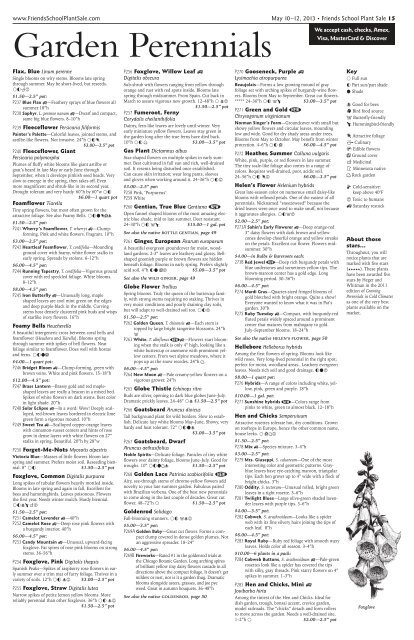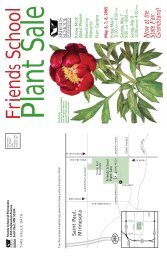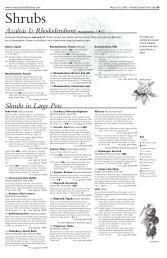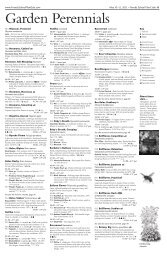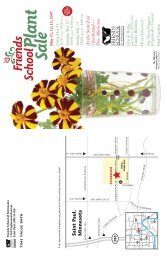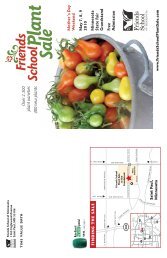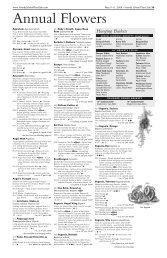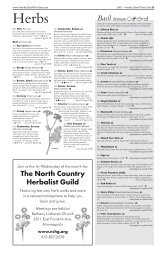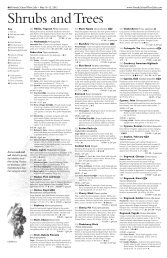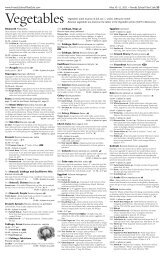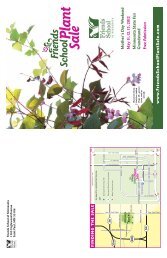View the 2013 56-page PDF here - Friends School Plant Sale
View the 2013 56-page PDF here - Friends School Plant Sale
View the 2013 56-page PDF here - Friends School Plant Sale
Create successful ePaper yourself
Turn your PDF publications into a flip-book with our unique Google optimized e-Paper software.
www.<strong>Friends</strong><strong>School</strong><strong>Plant</strong><strong>Sale</strong>.com May 10–12, <strong>2013</strong> • <strong>Friends</strong> <strong>School</strong> <strong>Plant</strong> <strong>Sale</strong> 15<br />
Garden Perennials<br />
We accept cash, checks, Amex,<br />
Visa, MasterCard & Discover<br />
Flax, Blue Linum perenne<br />
Single blooms on wiry stems. Blooms late spring<br />
through summer. May be short-lived, but reseeds.<br />
Í∏Â¥<br />
$1.50—2.5” pot:<br />
P237 Blue Flax ß—Fea<strong>the</strong>ry sprays of blue flowers all<br />
summer 18”h<br />
P238 Saphyr, L. perenne nanum ß—Dwarf and compact,<br />
same big blue flowers. 8–10”h<br />
P239 Fleeceflower Persicaria filiformis<br />
Painter’s Palette—Colorful leaves, jointed stems, and<br />
astilbe-like flowers. Not invasive. 24”h Í∏ç<br />
$3.00—3.5” pot<br />
P240 Fleeceflower, Giant<br />
Persicaria polymorpha<br />
Plumes of fluffy white blooms like giant astilbe or<br />
goat’s beard in late May or early June through<br />
September, when it develops pinkish seed heads. Very<br />
slow to emerge in <strong>the</strong> spring, <strong>the</strong>n takes off. Even<br />
more magnificent and shrub-like in its second year.<br />
Drought tolerant and very hardy. 60”h by 60”w Í∏<br />
$6.00—1 quart pot<br />
Foamflower Tiarella<br />
Tiny spring flowers, but most often grown for <strong>the</strong><br />
attractive foliage. See also Foamy Bells. Í∏Óç˝Ω<br />
$1.50—2.5” pot:<br />
P241 Wherry’s Foamflower, T. wherryi ß—Clumpforming.<br />
Pink and white flowers. Fragrant. 10”h<br />
$3.00—2.5” pot:<br />
P243 Heartleaf Foamflower, T. cordifolia—Mounding<br />
ground cover with foamy, white flower stalks in<br />
early spring. Spreads by stolons. 6–12”h<br />
$6.00—4.5” pot:<br />
P244 Running Tapestry, T. cordifolia—Vigorous ground<br />
cover with red speckled foliage. White blooms.<br />
8–12”h<br />
$8.00—4.5” pot:<br />
P245 Iron Butterfly ß—Unusually long, maple<br />
shaped leaves are cool mint green on <strong>the</strong> edges<br />
and deep purple-black in <strong>the</strong> middle. Curving<br />
stems host densely clustered pink buds and wisps<br />
of starlike ivory flowers. 16”h<br />
Foamy Bells Heuc<strong>here</strong>lla<br />
A beautiful intergeneric cross between coral bells and<br />
foamflower (Heuchera and Tiarella). Blooms spring<br />
through summer with spikes of bell flowers. Neat<br />
foliage similar to foamflower. Does well with hostas<br />
and ferns. Í∏Ó˝<br />
$4.00—1 quart pot:<br />
P246 Bridget Bloom ß—Clump-forming, green with<br />
brown veins. White and pink flowers. 15–18”h<br />
$12.00—4.5” pot:<br />
P247 Brass Lantern—Brassy gold and red mapleshaped<br />
leaves are really a beacon in a mixed bed.<br />
Spikes of white flowers on dark stems. Best color<br />
in light shade. 20”h<br />
P248 Solar Eclipse ß—In a word: Wow! Deeply scalloped,<br />
red-brown leaves bordered in electric lime<br />
green form a vigorous mound. 10”h<br />
P249 Sweet Tea ß—Scalloped copper-orange leaves<br />
with cinnamon-russet centers and hints of rose<br />
grow in dense layers with white flowers on 27”<br />
stalks in spring. Beautiful. 20”h by 28”w<br />
P250 Forget-Me-Nots Myosotis alpestris<br />
Victoria Blue—Masses of little flowers bloom late<br />
spring and summer. Prefers moist soil. Reseeding biennial.<br />
8” Í∏<br />
$1.50—2.5” pot<br />
Foxglove, Common Digitalis purpurea<br />
Long spikes of tubular flowers heavily mottled inside.<br />
Blooms in late spring and again in fall. Excellent for<br />
bees and hummingbirds. Leaves poisonous. Flowers<br />
<strong>the</strong> first year. Needs winter mulch. Hardy biennial.<br />
Í∏Ω˙Â¥<br />
$1.50—2.5” pot:<br />
P251 Camelot Lavender ß—40”h<br />
P252 Camelot Rose ß—Deep rose pink flowers with<br />
a burgundy interior. 40”h<br />
$6.00—4.5” pot:<br />
P253 Candy Mountain ß—Unusual, upward-facing<br />
foxglove. Fat spires of rose pink blooms on strong<br />
stems. 36–<strong>56</strong>”h<br />
P254 Foxglove, Pink Digitalis thapsis<br />
Spanish Peaks—Spikes of raspberry rose flowers in early<br />
summer over a trim mat of furry foliage. Thrives in a<br />
variety of soils. 12”h Í∏ Ω¥ $3.00—2.5” pot<br />
P255 Foxglove, Straw Digitalis lutea<br />
Narrow spikes of petite lemon yellow blooms. More<br />
reliably perennial than o<strong>the</strong>r foxgloves. 36”h Í∏ Ω¥<br />
$1.50—2.5” pot<br />
P2<strong>56</strong> Foxglove, Willow Leaf ß<br />
Digitalis obscura<br />
Sub-shrub with flowers ranging from yellow through<br />
orange and rust with red spots inside. Blooms late<br />
spring through midsummer. From Spain. Cut back in<br />
March to assure vigorous new growth. 12–48”h Í Ω¥<br />
$1.50—2.5” pot<br />
P257 Fumeroot, Ferny<br />
Corydalis cheilanthifolia<br />
Dainty, fern-like leaves are lovely until winter. Very<br />
early miniature yellow flowers. Leaves stay green in<br />
<strong>the</strong> garden long after <strong>the</strong> true ferns have died back.<br />
10”h Í∏ ‰ $3.00—3.5” pot<br />
Gas <strong>Plant</strong> Dictamnus albus<br />
Star-shaped flowers on multiple spikes in early summer.<br />
Best cultivated in full sun and rich, well-drained<br />
soil. It resents being disturbed once established.<br />
Can cause skin irritation; wear long pants, sleeves<br />
and gloves when working around it. 24–36”h Í∏¥<br />
$3.00—2.5” pot:<br />
P258 Pink, ‘Purpureus’<br />
P259 White<br />
P260 Gentian, True Blue Gentiana ◊<br />
Open funnel shaped blooms of <strong>the</strong> most amazing electric<br />
blue shade, mid to late summer. Deer resistant.<br />
24–30”h Í∏ ∫˙<br />
$15.00—1 gal. pot<br />
See also <strong>the</strong> native BOTTLE GENTIAN, <strong>page</strong> 49<br />
P261 Ginger, European Asarum europaeum<br />
A beautiful evergreen groundcover for moist, woodland<br />
gardens. 2-3” leaves are lea<strong>the</strong>ry and glossy. Bellshaped<br />
greenish purple or brown flowers are hidden<br />
beneath foliage. Blooms in early spring. Prefers slightly<br />
acid soil. 4”h ∏Ó ˝¥<br />
$5.00—3.5” pot<br />
See also <strong>the</strong> WILD GINGER, <strong>page</strong> 49<br />
Globe Flower Trollius<br />
Spring blooms. Truly <strong>the</strong> queen of <strong>the</strong> buttercup family,<br />
with strong stems requiring no staking. Thrives in<br />
very moist conditions and poorly draining clay soils,<br />
but will adapt to well-drained soil too. 긴<br />
$1.50—2.5” pot:<br />
P262 Golden Queen, T. chinensis ß—Each stem is<br />
topped by large bright tangerine blossoms. 24”h<br />
∫<br />
P263 White, T. albiflorus ◊ß—Flowers start blooming<br />
when <strong>the</strong> stalk is only 4” high, looking like a<br />
white buttercup or anemone with prominent yellow<br />
centers. From wet alpine meadows, w<strong>here</strong> it<br />
pops up as <strong>the</strong> snow recedes. 24”h ‰<br />
$6.00—4.5” pot:<br />
P264 New Moon ß—Pale creamy-yellow flowers on a<br />
vigorous grower. 24”h<br />
P265 Globe Thistle Echinops ritro<br />
Buds are silver, opening to dark blue globes June–July.<br />
Dramatic prickly leaves. 24–48” ÍΩ $1.50—2.5” pot<br />
P266 Goatsbeard Aruncus dioicus<br />
Tall background plant for wild borders. Slow to establish.<br />
Delicate lacy white blooms May–June, Showy, very<br />
hardy and heat tolerant. 72” Í∏ÓΩ<br />
$3.00—3.5” pot<br />
P267 Goatsbeard, Dwarf<br />
Aruncus aethusifolius<br />
Noble Spirits—Delicate foliage. Panicles of tiny white<br />
flowers over dainty foliage, blooms June–July. Good for<br />
troughs. 10” Í∏Ó‰Ω<br />
$1.50—2.5” pot<br />
P268 Golden Lace Patrinia scabiosifolia ◊<br />
Airy, see-through stems of chrome-yellow flowers add<br />
novelty to your late summer garden. Fabulous paired<br />
with Brazilian verbena. One of <strong>the</strong> best new perennials<br />
to come along in <strong>the</strong> last couple of decades. Great cut<br />
flower. 48–72”h Í<br />
$1.50—2.5” pot<br />
Goldenrod Solidago<br />
Fall-blooming stunners. Í∏ ∫Ω¥<br />
$5.00—3.5” pot:<br />
P269A Golden Baby—Great cut flower. Forms a compact<br />
clump covered in dense golden plumes. Not<br />
an aggressive spreader. 18–24”<br />
$6.00—4.5” pot:<br />
P269B Fireworks—Rated #1 in <strong>the</strong> goldenrod trials at<br />
<strong>the</strong> Chicago Botanic Garden. Long arching spires<br />
of brilliant yellow tiny daisy flowers cascade in all<br />
directions above <strong>the</strong> compact foliage. It doesn’t get<br />
mildew or rust, nor is it a garden thug. Dramatic<br />
blooms alongside asters, grasses, and joe pye<br />
weed. Great in autumn bouquets. 36–48”h<br />
See also <strong>the</strong> native GOLDENROD, <strong>page</strong> 50<br />
P270 Gooseneck, Purple ß<br />
Lysimachia atropurpurea<br />
Beaujolais—Forms a low growing mound of gray<br />
foliage set with arching spikes of burgundy-wine flowers.<br />
Blooms from May to September. Great cut flowers.<br />
***** 24–36”h Í∏ ∫˙ $3.00—3.5” pot<br />
P271 Green and Gold ◊<br />
Chrysogonum virginianum<br />
Norman Singer’s Form—Groundcover with small but<br />
showy yellow flowers and circular leaves, mounding<br />
low and wide. Good for dry shady areas under trees.<br />
Blooms from May to October. May benefit from winter<br />
protection. 4–6”h Í∏ ˝ $6.00—4.5” pot<br />
P272 Hea<strong>the</strong>r, Summer Calluna vulgaris<br />
White, pink, purple, or red flowers in late summer.<br />
The tiny scale-like foliage also comes in a range of<br />
colors. Requires well-drained, poor, acidic soil.<br />
24–36”h Í∏ ç¥<br />
$6.00—3.5” pot<br />
Helen’s Flower Helenium hybrids<br />
Great late-season color on numerous small daisy-like<br />
blooms with reflexed petals. One of <strong>the</strong> easiest of all<br />
perennials. Nicknamed “sneezeweed” because <strong>the</strong><br />
dried leaves were once used to make snuff, not because<br />
it aggravates allergies. Í∏∫¥<br />
$2.00—2.5” pot:<br />
P273A Sahin’s Early Flowerer ß—Deep orange-red<br />
3” daisy flowers with dark brown and yellow<br />
cones develop cheerful orange and yellow streaks<br />
on <strong>the</strong> petals. Excellent cut flower. Flowers midsummer.<br />
30”h<br />
$4.00—in Bulbs & Bareroots each:<br />
273B Red Jewel ◊—Deep rich burgundy petals with<br />
blue undertones and sometimes yellow tips. The<br />
brown-maroon center has a gold edge. Long<br />
blooming period. 30–36”h<br />
$6.00—4.5” pot:<br />
P274 Mardi Gras—Quarter-sized fringed blooms of<br />
gold blotched with bright orange. Quite a show!<br />
Everyone wanted to know what it was in Pat’s<br />
garden. 30”h<br />
P275 Ruby Tuesday ß—Compact, with burgundy-red<br />
fluted petals widely spaced around a prominent<br />
center that matures from mahogany to gold.<br />
July–September blooms. 18–24”h<br />
See also <strong>the</strong> native HELEN’S FLOWER, <strong>page</strong> 50<br />
Hellebore Helleborus hybrids<br />
Among <strong>the</strong> first flowers of spring. Blooms look like<br />
wild roses. Very long-lived perennial in <strong>the</strong> right spot;<br />
perfect for moist, woodland areas.. Lea<strong>the</strong>ry evergreen<br />
leaves. Needs rich soil and good drainage. ∏Ó¥<br />
$8.00—1 quart pot:<br />
P276 Hybrids—A range of colors including white, yellow,<br />
pink, green and purple. 18”h<br />
$10.00—1 gal. pot:<br />
P277 Sunshine hybrids ◊—Colors range from<br />
pinks to white, green to almost black. 12–18”h<br />
Hen and Chicks Sempervivum<br />
Attractive rosettes tolerate hot, dry conditions. Grown<br />
on rooftops in Europe, hence <strong>the</strong> o<strong>the</strong>r common name,<br />
house leeks. Í ˝‰¥<br />
$1.50—2.5” pot:<br />
P278 Mix ß—Species mixture. 3–4”h<br />
$3.00—2.5” pot:<br />
P279 Mrs. Giuseppi, S. calcareum—One of <strong>the</strong> most<br />
interesting color and geometric patterns. Grayblue<br />
leaves have eye-catching maroon, triangular<br />
tips. Each hen grows up to 4” wide with a flock of<br />
bright chicks. 3”h<br />
P280 Oddity, S. tectorum—Unusual rolled, bright green<br />
leaves in a tight rosette. 3–6”h<br />
P281 Twilight Blues—Large olive-green shaded lavender<br />
leaves with purple tips. 3–6”h<br />
$4.00—3.5” pot:<br />
P282 Cobweb, S. arachnoideum—Looks like a spider<br />
web with its fine silvery hairs joining <strong>the</strong> tips of<br />
each leaf. 8”h<br />
$6.00—4.5” pot:<br />
P283 Royal Ruby—Ruby red foliage with smooth waxy<br />
leaves. Holds color all season. 3–4”h<br />
$10.00—6 plants in a pack:<br />
P284 Cobweb Buttons, S. arachnoideum ß—Pale-green<br />
rosettes look like a spider has covered <strong>the</strong> tips<br />
with silky, gray threads. Pink starry flowers on 4”<br />
spikes in summer. 1–3”h<br />
P285 Hen and Chicks, Mini ß<br />
Jovibarba hirta<br />
Among <strong>the</strong> tiniest of <strong>the</strong> Hen and Chicks. Ideal for<br />
dish garden, trough, bonsai accent, crevice garden,<br />
model railroads. The “chicks” detach and form rollers<br />
to move across <strong>the</strong> garden. Needs a well-drained site.<br />
1–2”h Í<br />
$2.00—2.5” pot<br />
Key<br />
Í Full sun<br />
∏ Part sun/part shade<br />
Ó Shade<br />
Ω Good for bees<br />
ı Bird food source<br />
∫ Butterfly-friendly<br />
˙ Hummingbird-friendly<br />
ç Attractive foliage<br />
Ç Culinary<br />
´ Edible flowers<br />
˝ Ground cover<br />
 Medicinal<br />
˜ Minnesota native<br />
‰ Rock garden<br />
† Cold-sensitive:<br />
keep above 40°F<br />
¥ Toxic to humans<br />
ß Saturday restock<br />
About those<br />
stars…<br />
Throughout, you will<br />
notice plants that are<br />
marked with five stars<br />
(★★★★★). These plants<br />
have been awarded five<br />
stars by Heger and<br />
Whitman in <strong>the</strong> 2011<br />
edition of Growing<br />
Perennials in Cold Climates<br />
as one of <strong>the</strong> very best<br />
plants available on <strong>the</strong><br />
market.<br />
Foxglove


